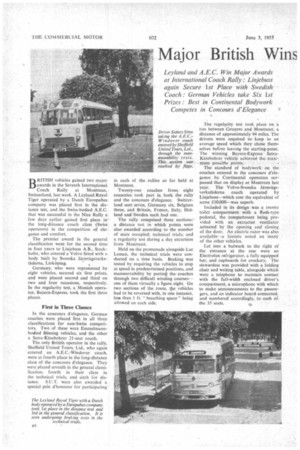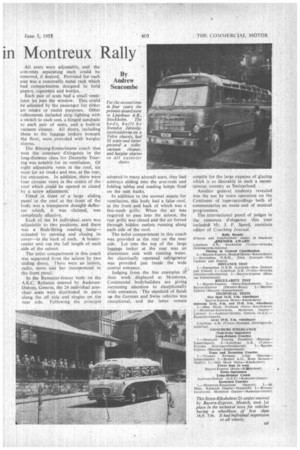Major British Wins in Montreux Rally
Page 42

Page 43

If you've noticed an error in this article please click here to report it so we can fix it.
Leyland and A.E.C. Win Major Awards at International Coach Rally: Linjebuss again Secure 1st Place with Swedish Coach : German Vehicles take Sfx 1st Prizes : Best in Continental Bodywork Competes in Concours d'Elegance
BR1TISH vehicles gained two major awards in the Seventh International Coach Rally at Montreux, Switzerland, last week. A Leyland Royal Tiger operated by a Dutch Europabus company was placed first in the distance test, and the Swiss-bodied A.E.C. that was successful in the Nice Rally a few days earlier gained first place iii the long-diitance coach class (Swiss operators) in the competition of elegance and comfort.
The premier award in the general classification went for the second time in four years to Linjebuss A.B., Stockholm, who entered a Volvo fitted with a body built by Svenska Jrnvagsverkstaderna, Linkoping.
Germany, who were represented by eight vehicles, secured six first prizes, and were placed second and third on two and four occasions, respectively. In the regularity test, a Munich operator. Bayern-Express, took the first three places.
First in Three Classes
In the concours d'elegance, German coaches were placed first in all three classifications for non-Swiss competitors. Two of these were Emmelmannbodied Bussing vehicles, and the other a Setra-Kassbohrer 2I-seat coach.
The only British operator in the rally, Sheffield United Tours. Ltd., who again entered _ an A.E,C.-Windover coach, were at fourth place in the long-distance class of the concours d'elegance. They were placed seventh in the general classification, fourth in their class in the technical trials, and sixth for distance. S.U.T. were also awarded a special prix d'honneur for participating
The Leyland Royal Tiger with a Dutch body operated by a Europahus company took 1st place in the distance test and 3rd in the general classification. It is seen undergoing braking tests in the technical trials.
in each of the rallies so far held at Montreux.
Twenty-one coaches from eight countries took part in both the rally and the concours d'elegance. Switzerland sent seven, Germany six, Belgium three, and Britain, France, Italy, Holland and Sweden each had one.
The rally comprised three sections: a distance test in which points were also awarded according to the number of seats occupied; technical trials; and a regularity test during a day excursion from Montreux.
Held on the promenade alongside Lac Leman, the technical trials were conducted on a time basis. Braking was tested by requiring the vehicles to stop at speed in predetermined positions, and manceuvrability by putting the coaches through two difficult winding courses— one of them virtually a figure eight. On two sections of the route, the vehicles had to be reversed with, in one instance, less than 1 ft. " breathing space" being allowed on each side. The regularity test took place on a run between Gruyere and Montreux, a distance of approximately 44 miles. The drivers were required to keep to an average speed which they chose themselves before leaving the starting-point. The winning Bayern-Express SetraKassbohrer vehicle achieved the maximum possillle points.
The standard of bodywork on the coaches entered in the concours d'elegance by Continental operators surpassed that on display at Montreux last year. The Volvo-Svenska JarnvSgsverkstilderna coach operated by Linjebuss—which cost the equivalent of some f10,000—was superb.
Included in its design was a roomy toilet compartment with a flush-type pedestal, the compartment being provided with an extractor ventilator actuated by the opening and closing of the door. An electric razor was also available—a feature noted on many of the other vehicles.
Let into a bulwark to the right of the entrance at the rear were an Electrolux refrigerator, a fully equipped bar, and cupboards for crockery. The stewardess was provided with a folding chair and writing table, alongside which were a telephone to maintain contact with the full-width enclosed driver's. compartment, a microphone with which to make announcements to the passengers, and an indicator board connected, and numbered accordingly, to each of the 35 scats.
All seats were adjustable, and the arm-rests separating each could be removed, if desired. Provided for each scat was a removable metal rack which had compartments designed to hold papers, cigarettes and bottles.
Each pair of seats had a small ventilator let into the window. This could be adjusted by the passenger for either air intake or outlet purposes. Other refinements included strip lighting with a switch to each seat, a hinged sunshade to each pair of seats, and a built-in %acuum cleaner. All doors, including those to the luggage lockers beneath the floor, were provided with burglar alarms.
The Bassing-Emmelmann coach that won the concours d'elegance in the long-distance class for Deutsche Touring was notable for its ventilation. Of eight adjustable vents in the roof, six were for air intake and two, at the rear, for extraction. In addition, there were four circular vents in the centre of the roof which could be opened or closed hy a screw adjustment.
Fitted in front of a large sliding panel in the roof at the front of the body was a transparent draught deflector which, it was claimed, was completely effective.
Each of the 34 individual seats was adjustable to two positions, and there was a flush-fitting reading lamp— actuated by opening and closing its cover—in the back of each. A heatercooler unit ran the full length of each side of the saloon.
The toilet compartment in this coach was separated from the saloon by two sliding doors. There were an icebox, radio, stove and bar incorporated in the front panel.
In the Ramseier-Jenzer body on the A.E.C. Reliance entered by AudersetDubois, Geneva, the 24 individual armchair scats were distributed in pairs along the off side and singles on the near side. Following the principle adopted in many aircraft seats, they had ashtrays sliding into the arm-rests and folding tables and reading lamps fixed on the seat backs.
In addition to the normal means for ventilation, this body had a false roof, at the front and back of which was a fine-mesh grille. When the air was required to pass into the saloon, the rear grille was closed and the air forced through hidden outlets running along each side of the roof.
The toilet compartment in this coach was provided at the rear on the near side. Let into the top of the large luggage locker at the rear was an aluminium sink with running water. An electrically operated refrigerator was provided just inside the wide central entrance.
Judging from the fine examples of their work displayed at Montreux, Continental bodybuilders are giving increasing attention to exceptionally wide entrances. The standard of finish tan the German and Swiss vehicles was exceptional, and the latter remain
notable for the large expanse of glazing which is so desirable in such a mountainous country as Switzerland. .
Another general tendency revealed was the use by tours operators on the Continent of tape-recordings both of commentaries en route and of musical programmes..
The international panel of judges in the concours d'elegance this year included Mr. J. F. Speed, associate editor of Coaching Journal.
Rally Results (Chassis and bodybuilders names in brackets) OREMIER AWARD
Linjebuss A'71).. Stockholm (Volvo—Svenska Jarnvagsverkstaderna).
Placing In General Classification 2.—Bayern-Express, Munich (Setra—Klivsbohrerh 3.—Europabus N.B.M. Zeist (Leyland—Den Oudsten and Zonen).
DISTANCE TEST I.—Europabus N.B.M. (Leyland—Den Oudsten and Zonen); 2.—Linjebuss A.B. (Volvo—Svenska larnvattsverkstaderna); 3.—Bayern-Express (Missing Emmelmann).
REGULARITY TEST 1.—Bayent-Express (Setra-Kassbohrer); 2.— Bayern-Express (Daimler-Benz): Express (Biissing—Emmelatann).
TECHNICAL TESTS (km than 16-ft. 54a. wheelbase) Bayern-Express (Setra—Kassbohrer) (between 16-15. 54a. and 1941. 5-In. wheelbase) I.—Max }loch. Freiburg (Setra—Kavibuhrcr): 2 —Montreux-Excursions. Montreux (SaurerEauber); 3.—Auderset-Dubois. Geneva (A.E.C.— Ramseier-Jenzer).
(over 19-ft. 5-10. wheelbase) Liniebuss A.B. (Volyo—Svenska Iartivagsvcrkstsiderna).
CONCOURS D'ELEGANCE (Non-S's Is, Operators) Long-distance Coaches I.—Deutsche Touring. Frankfurt (BasculeEnunelmann): 2.—Liniebuss A.S. (Volvo— Svenska itirnviigsverksifiderna); 3.—BayernExpress (lussing--Emmelmann).
Tones and Etteursloa Coaches
l.—Voyaees Pullman, Liege (Thissi TVSEmmermann): 2.—Bonner A.(1.„ Bonn (Krauss— Maffei): 3.—Max Hoch (Setra—Kassbohrer).
Fewer than 24 seats Bayern-Express (Setra—Kliggbohrer). (Swiss Operators)
Loki-distance Coach Auderset-Dubois (A.E.C.—R amseier-1 enzer). Excursion Coaches 1.—Montreux-Eiteurs:ons (Satarer); 2.—M. Marti itallnach (Saurer—Gangloti): 3.—RivieraExcursions Montreux (Saurer—Karnseier-lenzer).
This Setra-Klissbohrer 21-seater entered by Bayern-Express. Munich, took 1st place in the technical tests for vehicles having a wheelbase of less than 16 ft. 5 in. It had individual suspension
to all wheels.




































































































